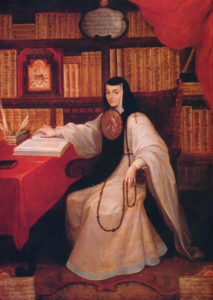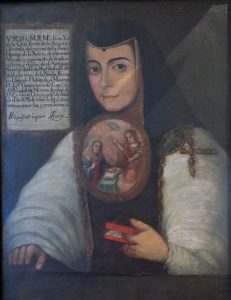The Passions of Sor Juana Inez de la Cruz
Sor Juana Ines de la Cruz (November 12, 1648 – April 17, 1695), was passionate about educational access, books, learning, equality and women. She was a 17th century nun, self-taught scholar and acclaimed writer. She was born in San Miguel Nepantla near Mexico City on November 12, 1648. Her parents were Isabel Ramirez, a Criolla (native-born Spanish) woman, and Captain Pedro Manuel de Asbaje of Spain. They didn’t marry. Juana lived a comfortable life on the estate of her maternal grandfather. She educated herself in her grandfather’s library. Juana was a high-spirited girl who loved learning and the life of the mind. She was also very beautiful to which her portraits will attest. She was fluent in Spanish, Nahuatl and Latin.
When she was 16 she asked for her parents’ permission to disguise herself as a youth to attend the university, which did not accept women. Her family sent her to court to meet influential people and find a husband. Instead, in 1669, she entered the monastery of the Hieronymite nuns. She choose to become a nun “to have no fixed occupation which might curtail my freedom to study.”
As a nun, she was free to study the 4,000 books she collected, mostly from her grandfather’s library. Her cell became a salon for the intellectual elite. She gained the patronage of the viceroy, Marquis de la Laguna, and the vicereine of New Spain, Countess Maria Luisa de Paredes. They supported and protected her, and had her works published in Spain. The two women became passionate friends. Whether or not a physical relationship existed isn’t clear, but love and desire definitely existed. In her poem, “My Lady” Sor Juana Inez describes her emotions: 
“I love you with so much passion, neither rudeness nor neglect can explain why I tied my tongue, yet left my heart unchecked.
The matter for me was simple; love for you was so strong, I could see you in my soul and talk to you all day long.
How unwisely my ardent love, which your glorious sun inflamed, sought to feed upon your brightness, though the risk of your fire was plain!
Let my love be ever doomed if guilty in its intent, for loving you is a crime of which I will never repent.”
Sor Juana’s sermons, which were transcribed and widely circulated, paid unusual attention to gender imagery. She said that she had been conceived as a male but was changed in utero by God to become female. She delighted in Jesus’ self-reference as a mother hen and spoke of the male and female aspects of God. She believed this mixture of identities also resided in the human soul:
“And all those who seek in me a father,” she wrote, “will find me a father. And those who seek in me a mother, will find in me a mother. And those who seek in me a husband, will find in me a husband. And those who seek in me a bride, will find a bride. And those who seek in me a brother, or a friend, or a neighbor, or a companion, likewise will find in me everything they desire.”
In 1692, Church authorities cracked down on Sr. Juana, not because of gossip or lesbian love poetry, but because she openly challenged societal and ecclesiastical values and norms on women. In her most famous work “Respuesta a Sor Filotea” she defends women’s rights to educational access and opportunity to serve as intellectual authorities. Sor Juana argued that women could educate other women.
Threatened by the Inquisition, Sor Juana was silenced for the final three years of her life. There are documents showing her agreeing to undergo penance. One such document is signed, “Yo, la Peor de Todas” (I, the Worst of all Women”). Her books, scientific and musical instruments were confiscated and sold. Sor Juana died three years later nursing her sister nuns during a cholera epidemic. She was 46. Sor Juana is buried in the site of her former convent, San Jeronimo, at the University of the Cloister of Sor Juana in Mexico City.
Sor Juana lay in oblivion for several hundred years until Phoenix-like she sprang into life. Two of the sparks were books and research done by writers Octavio Paz of Mexico and Dorothy Schons of the University of Texas. 
The relationship between Sor Juana and Countess Maria Luisa is explored in “Sor Juana’s Second Dream” a book published in 1999 by Dr. Alicia Gaspar de Alba. She also writes about Sor Juana in “(Un)framing the Bad Woman: Sor Juana, Malinche, Coyolxauqui and Other Rebels with a Cause,” published in 2014. A series of photos inspired by Sor Juana’s life and passions was created by Alma Lopez in 2019. Gaspar de Alba and Lopez, married to each other since 2008, have also explored lesbian connections with Our Lady of Guadalupe.
Maria Luisa Bemberg, one of Latin America’s foremost female directors, imagines the love between Juana and Maria Luisa in the 1990 film, “I, the Worst of All.” The film was Argentina’s entry for Best Foreign Language Film that year.
How far did the passions of Sor Juana go? My feeling is that she had an unbridled imagination, a tormented yearning and a chaste life. I’m sure she shared some tender, passionate, embraces with Maria Luisa, but a lack of time, privacy and mutual restraint kept a lid on any other expressions. But what a kiss it must have been!


April 2nd, 2021 at 5:08 pm
We in Ireland are currently at the latter end of a decade of centenaries, where women are being written back into the history of the revolutionary period (1913-1924) and same sex relationships, hitherto glossed over, are being openly recognised and explored.
Meanwhile the Inquisition (CDF) continues to silence and oppress those clerics who advocate for married and women priests, same-sex marriage, and open acknowledgement and acceptance of LBTQ+ in the religious life.
Civil life is leaving the Church far and fast behind.
April 3rd, 2021 at 8:20 am
Polo,
Happy Easter! Wishing you a joyful holiday and spring.
Much love,
Karen
April 3rd, 2021 at 1:59 pm
And to ye to, heartfelt.
Pól